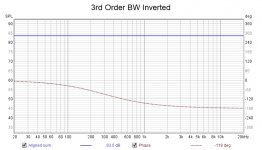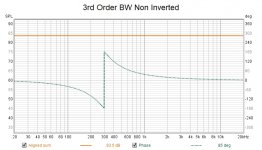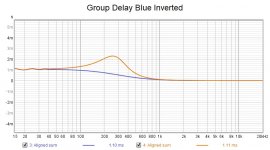This is a further complication, and is in addition to the LR -3dB that has been described. To show this, lobing varies from case to case.if any cancellations arise anywhere in the polar response, which we know they do, they have to reduce the integrated power response summation across the frequency range
C'mon now, there's no "jump" except when ypu eyeball the (usually theoretical) measurements.*
Using trick test tones and doing a quick A-B switch, maybe differences can be detected (which rarely can be labelled good or bad). But then so many other factors can be switched inadvertently and inescapably, that lab test tones tell us little about audibility in the wild.
BTW, posts which report here to fore unreported subtle audible effects lead me to ask, "Have you ever done blind testing?" For example, you could ask your spouse to make the switch and see if you reliably tell A from B.
B.
* How about slow glide tones? Deserves a separate thread.
I think we partly are talking about different things here.
First, is time based (mis-)alignment between elements audible? (quick answer: yes)
Second, is it significant? (quick answer: it depends)
First, audible:
You don't have to play a lot of test tones to hear a misalignment, it primarely appear as a deviation from the natural sound of an instrument. E.g. Dave Wilson spent a lot of time to adress this (WAMM Master Chronosonic—Magnum Opus - YouTube), aming at a precision of 2us.
Second (and maybe more interesting), significant:
I have two listening positions, one "super sweetspot" just in front of (1.7m) the speakers with a chair I put there for concentrated listening. This is not so far from a near field listening situation with boundary reflections playing a reduced role. Here pase misalignment is significant, or as one of my friends commented, the sound is more relaxed when in phase.
The other listening position is in the sofa close to the back wall. Here the difference is less significant if audible at all due to much higher level of boundary reflections.
The kind of music played is also of high significance. Live recordings with real instruments is much more sensitive than classic rock (think Springsteen).
For me, the matter of phase alignment, and how this best is implemented was the reason foir starting this thread, and was primarely based on listening impressions from real (live) music played (at the super sweetspot). I simply found this to be an area of potential improvement with high enough significance. If my primary situation would have been the sofa playing classic rock, I would proably not focused on this issue.
Second (and maybe more interesting), significant:
I have two listening positions, one "super sweetspot" just in front of (1.7m) the speakers with a chair I put there for concentrated listening. This is not so far from a near field listening situation with boundary reflections playing a reduced role. Here pase misalignment is significant, or as one of my friends commented, the sound is more relaxed when in phase.
I've found fullrange or coaxial, though to a lesser degree, ideal for this situation.
...but not for the back wall sofa, or other posiotions (due to beaming)?
I'm trying to find a reasonable compromise for both situations with a good near field experience and an good overall sound in the whole room.
One solution was to improve the near field experience by reducing the imperfection introduced by phase alignment, which to my current knowledge not have a negative impact in other listening positions.
I'm trying to find a reasonable compromise for both situations with a good near field experience and an good overall sound in the whole room.
One solution was to improve the near field experience by reducing the imperfection introduced by phase alignment, which to my current knowledge not have a negative impact in other listening positions.
For me, the matter of phase alignment, and how this best is implemented was the reason foir starting this thread, and was primarely based on listening impressions from real (live) music played (at the super sweetspot). I simply found this to be an area of potential improvement with high enough significance. If my primary situation would have been the sofa playing classic rock, I would proably not focused on this issue.
Do not underestimate hard rock, many bands today have a bassist with low b (31hz) and a very clear drum mix. It is a good rating if the system can handle a compact mix without causing ear pain from lobing and peaks etc. If good mixed metal sounds good, everything sounds good 😀
Silence Is Killing Me - YouTube
With unassailable logic, you dismiss the well-known and likely audible consequences of tilting your speaker cab in favour of supporting a notion (audibility of relative phase outside lab testing) that may have no basis in reality.
B.
I'm seriously interested in more information about the drawbacks or negative effects of slightly tilting the baffle.
I have done some google homework, but all I come up with is people explaining how to align drivers, not negative effects.
Anyone with links or a direct explanation?
I agree. Generally when you see correlated or uncorrelated signals being discussed(ie like pink noise test signals) it has nothing to do with spacial variance of the phase.
In some further reading of Self's Design of Active Crossovers,
i see he occasionally adds "in-phase" to "correlated" when talking about power response.
...such that 'correlated' expands to 'correlated in-phase'.
I think he uses them interchangeably, assuming everyone gets the implied in-phase part, when reading his book.
I'm glad your melon did not explode trying to wrestle with it 🙂 It's hard to quote someone (Douglas Self) without using the terms they use, sengpielaudio uses similar terms in their calculators they even put in phase in brackets next to correlated 😉
Haha thx fluid !
But the real risk to my mellon is not explosion...it's implosion ....
you know, from the intense vacuum between me ears 😀
And yep, gotta love the sengpielaudio calculators....
audio screwdrivers and wrenches so to speak.
I'm seriously interested in more information about the drawbacks or negative effects of slightly tilting the baffle.
I have done some google homework, but all I come up with is people explaining how to align drivers, not negative effects.
Anyone with links or a direct explanation?
The only drawback to tilting i've ever heard, is that on-axis listening tuning is forced into having to optimize to an off-axis driver response (by the degree of the tilt).
Doesn't sound like a biggie to me as long as the tilt is no more than 10 maybe 15 degrees.
My tilt is in the range of 0.9 degrees, which then should be of very limited significance if audible at all (?).
At least it seems to be a price worth paying to achive a better phase alignment between the elements.
At least it seems to be a price worth paying to achive a better phase alignment between the elements.
You may well not be discussing quite the same thing as Ben is talking about.I think we partly are talking about different things here.
First, is time based (mis-)alignment between elements audible? (quick answer: yes)
Second, is it significant? (quick answer: it depends)
There is almost universal agreement that phase matching through the crossover is important and needs to be good, exactly how good is where the disagreements would start.
This is one of those situations where good measurements are helpful because it might only seem like a small time misalignment but it can wreak havoc on the response. Sometimes just slightly wrong is worse than very wrong. If the measurements looked extremely similar and big audible changes were being claimed is more what I think Ben is getting at.
One benefit of the LR crossover is that the main lobe points straight ahead, if you tilt the baffle you will also tilt the lobe.I'm seriously interested in more information about the drawbacks or negative effects of slightly tilting the baffle.
Anyone with links or a direct explanation?
All of those things are trade offs in a design, some drivers are smoother off axis, it's the overall result that matters.My tilt is in the range of 0.9 degrees, which then should be of very limited significance if audible at all (?).
At least it seems to be a price worth paying to achive a better phase alignment between the elements.
As you say with less than 1 degree of tilt nothing extreme is being done to get concerned about.
Thanks. Pretty clear in dismissing all that jaw-jaw about phase purity. And that in "real life" and in audio, phases are all over the map and just doesn't matter.
Any chance the phase purists at DIYaudio will be interested?
He makes an insightful comment that sometimes A-B testing can sometimes demonstrate differences that aren't meaningful.
With Bolserst, Toole, and my wife, he's my most trusted source.
B.
Last edited:
Phase can be a difficult topic to talk about.Pretty clear in dismissing all that jaw-jaw about phase purity. And that in "real life" and in audio, phases are all over the map and just doesn't matter.
Any chance the phase purists at DIYaudio will be interested?
This quote from that article says a lot to me
"This is relative phase between separate sound sources, and is very audible indeed. What we need to concern ourselves with is relative phase between sources, not absolute phase or phase shift".
Another one that is in line with what I have found when experimenting with phase correction for low frequencies.
"If there is enough phase shift, this gives rise to group delay, which may become audible if it exceeds the threshold of audibility. Fortunately, these thresholds are generally well in excess of the delay caused by any commonly used filter or crossover network".
Is there?There is almost universal agreement that phase matching through the crossover is important and needs to be good,
What about what is said in Rod Elliot's link..
Human hearing is not sensitive to absolute phase, and responds to relative phase only if it causes a peak or dip in the frequency response
I read that quote as saying it is. If you don't get a good phase match through the crossover you will likely get an amplitude issue.
The relative phases need to match up to avoid cancellation or addition.
The relative phases need to match up to avoid cancellation or addition.
Is there?
....
I prefer Bob McCarthy´s point of view.
Keep the relative phase to less than 90 degree as long as the level difference is less than 10dB, 20dB would be better of course. 🙂
I prefer Bob McCarthy´s point of view.
Bob McCarthy from Sound System Engineering pg87
"An acoustic crossover is the most important type of summation junction. It is the one where the levels of two or more sources are equal, therefore the stakes are the highest. It is this position that will benefit the most from being “in phase” and be damaged the most from being “out of phase.” As a result we will make every effort to align the phase responses at the acoustical crossover" (Emphasis added).
This is the point I was trying to make in case it wasn't clear.
Again, this could be taken two ways.
What do you think about the theoretical Butterworth third order crossover? What about its benefits?
What do you think about the theoretical Butterworth third order crossover? What about its benefits?
I can only see one meaning, what does it say to you?
3rd order Butterworth seems interesting. Flat voltage and power but with a lobe tilt. Flat whether inverted or non inverted giving the opportunity to change the all pass phase response. Inverted avoids the group delay peak.
This is synthetic 300 Hz BW3, phase slopes aligned in REW with a 1.1ms delay, anything else gives a dip, a peak or ripple. I suppose a dip or peak could be used to get a flatter summed response from non flat drivers.
3rd order Butterworth seems interesting. Flat voltage and power but with a lobe tilt. Flat whether inverted or non inverted giving the opportunity to change the all pass phase response. Inverted avoids the group delay peak.
This is synthetic 300 Hz BW3, phase slopes aligned in REW with a 1.1ms delay, anything else gives a dip, a peak or ripple. I suppose a dip or peak could be used to get a flatter summed response from non flat drivers.
Attachments
- Home
- Loudspeakers
- Multi-Way
- Active LR4 crossover phase matching using a DSP


